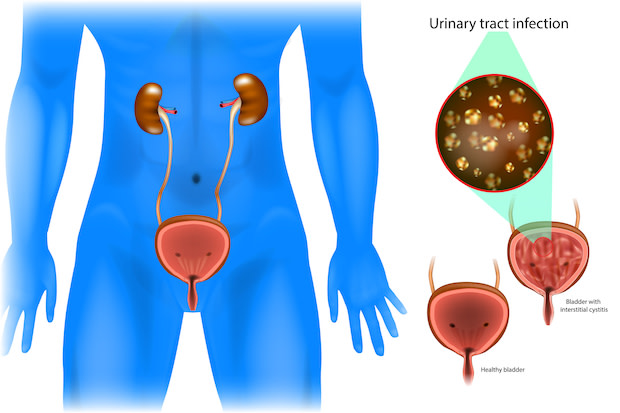Table of Contents
I. Symptoms of Bladder Problems
II. Behavioral Therapies for Overactive Bladder
Symptoms of Bladder Problems
Several conditions may affect your bladder over the years. If you suffer from bladder disorders like recurrent UTIs, cystitis (bladder infections), or overactive bladder syndrome, you have likely sought quick and easy treatment methods. Your doctor may prescribe medications like Monurol (fosfomycin) to ease unpleasant symptoms and improve treatment times.
The urinary system is made up of several complicated processes, so each treatment has its method. If you have an abnormal urge to urinate or pain in your bladder region, you will want to talk to your doctor. Each bladder problem has its symptoms, but general warning signs include:
- Pain or burning when you urinate
- Blood in your urine
- Pain in the stomach
- Having to urinate when there is little urine in the bladder
- Urinating frequently (eight or more times a day)
- Unintentional urine loss
- Cloudy urine [1]
These symptoms can be very unpleasant and affect your everyday life. Once diagnosed, your doctor will choose a treatment method for you. Read on to learn more about various treatments for bladder disorders. When you are suffering from overactive bladder (OAB), you may be prescribed Detrol (tolterodine), Detrol LA (tolterodine LA), or Toviaz. These medications work to relax the bladder, relieve symptoms of OAB, and reduce episodes of unintentional urine loss. Along with these drugs, you may also participate in behavioral interventions. These therapies may include: Pelvic floor muscle exercises: Kegel exercises can strengthen the pelvic floor muscles and urinary sphincter. An easy way to identify pelvic floor muscles is to stop urinating mid-stream when using the restroom. Both men and women can participate in kegels, which can lead to an improvement in OAB symptoms. Your doctor may help you learn how to do these exercises. Biofeedback: This treatment method for OAB involves using devices to help people become aware of their bodily functions. You are connected to electrical sensors that receive information about your body. Biofeedback sensors allow OAB patients to teach you how to make changes in your body and suppress urinary urgency. Bladder training: If you feel a persistent urge to urinate, you can train your bladder to delay using the restroom. You can start bladder training with small delays around 30 minutes and work up to urinating every three to four hours. [2] UTIs can affect any part of the urinary system, including the kidneys, ureters, bladder, and urethra. Minor symptoms like discharge and burning with urination occur with infections of the urethra. Symptoms get progressively more severe as the infection affects the bladder and kidneys. Antibiotics like Keflex (cephalexin) and Macrobid (nitrofurantoin) are used to treat mild to moderate symptoms. UTIs are fairly common and typically clear up within a few days of treatment, but some may need to continue antibiotics for several weeks. If you are prone to UTIs and experience them regularly, you may need more intense treatment methods. Your doctor may recommend: To avoid the unpleasant conditions of UTIs, it is important to stay hydrated and avoid bladder-irritating beverages such as coffee, alcohol, and citrus juices. Drinking cranberry juice in juice or tablet form may also help fight infection. Research into the use of cranberry juice is inconclusive, but it does not harm the body. Do not drink cranberry juice if you are taking blood thinners. [1] Cystitis refers to an inflammation of the bladder, and it is typically caused by a urinary tract infection that spreads to the bladder. It may also occur due to radiation therapy, long-term use of catheters, and feminine hygiene sprays. Antibiotics like Monurol (fosfomycin) are used to treat this disorder initially. If cystitis occurs repeatedly, you may have to go through a longer antibiotic treatment and see a urologist for urinary abnormalities that may be causing frequent cystitis. [3] Interstitial cystitis is a slightly different disorder that causes chronic bladder pressure and pain. The symptoms of this condition can range from mild to severe. This type of cystitis is not directly related to UTIs but may be caused by a defect in the bladder's protective lining. Infection, allergy, genetics, or an autoimmune reaction may also cause interstitial cystitis. You may receive the following treatments: Transcutaneous electrical nerve stimulation (TENS): TENS relieves pelvic pain and reduces urinary frequency through mild electrical. Electrical wires will be placed on the lower back, and your doctor will determine the length and frequency of this therapy. TENS may help control the bladder and release substances that block pain. Bladder surgery: In some cases, doctors may recommend surgery if you have severe interstitial cystitis. Those with severe pain are usually unable to hold very much urine in the bladder, which can be fixed with surgery. Surgery may involve instruments through the urethra to burn off ulcers present in some interstitial cystitis cases. Your surgeon may also increase the bladder's capacity by putting a patch of your intestine on the bladder. [4] The content in this article is intended for informational purposes only. This website does not provide medical advice. In all circumstances, you should always seek the advice of your physician and/or other qualified health professionals(s) for drug, medical condition, or treatment advice. The content provided on this website is not a substitute for professional medical advice, diagnosis, or treatment.
Behavioral Therapies for Overactive Bladder
Urinary Tract Infections

Treatments for Cystitis

